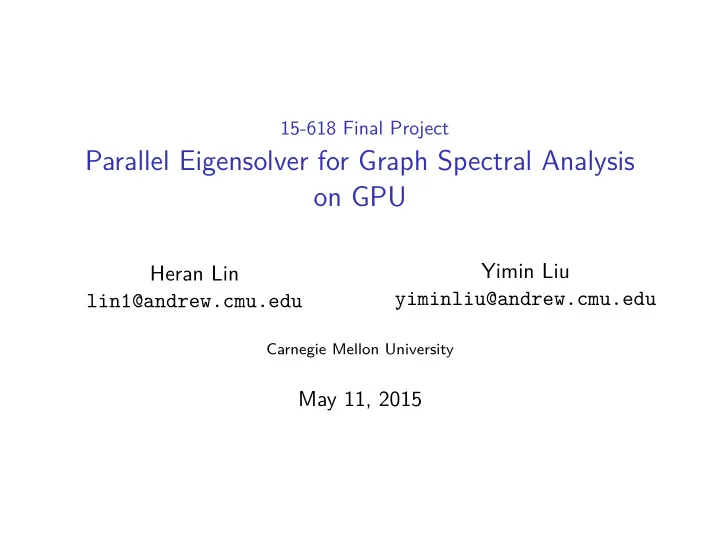

15-618 Final Project Parallel Eigensolver for Graph Spectral Analysis on GPU Yimin Liu Heran Lin yiminliu@andrew.cmu.edu lin1@andrew.cmu.edu Carnegie Mellon University May 11, 2015
Overview ◮ Undirected graph G = ( V , E ) ◮ Symmetric square matrix M associated with graph G (adjacency matrix A , graph Laplacian L , etc.) ◮ Eigenvalues of M encodes interesting properties of the graph Mx = λ x
Eigendecomposition Overview ◮ Transform M to a symmetric tridiagonal matrix T m ◮ Calculate eigenvalues of T m ⇒ ⇒ (easy) Lanczos
The Lanczos Algorithm for Tridiagonalization α 1 β 2 ... β 2 α 2 T m = ... ... β m β m α m 1. v 0 ← 0 , v 1 ← norm-1 random vector, β 1 ← 0 2. for j = 1 , . . . , m ◮ w j ← Mv j ◮ α j ← w ⊤ j v j ◮ w j ← w j − α j v j − β j v j − 1 ◮ β j +1 ← � w j � 2 ◮ v j +1 ← w j /β j +1 Potential parallelism for CUDA: matrix-vector product , dot-product, SAXPY
Challenges Characteristics of M ◮ Really sparse ◮ Skewed distribution of non-zero elements ◮ Example: power-law node degree distribution in social networks
Compressed Sparse Row (CSR) Matrix-Vector Multiplication (SPMV) · · · Row 0 Row 1 Row 2 column index = ×
Naive Work Assignment Thread 0 Thread 1 Thread 2 · · · Row 0 Row 1 Row 2 Row 0 Result ◮ Each thread is responsible for one row ◮ Work imbalance issues
Warp-based Work Assignment Warp 0 Warp 1 Warp 2 · · · Row 0 Row 1 Row 2 Partial Sum Row 0 Result ◮ Each warp (32 threads) is responsible for one row ◮ Reduce partial sum in shared memory
Warp-based Work Assignment for Row Groups Warp 0 Warp 1 · · · Row 0 Row 1 Row 2 Row 0 Result Row 1 Result ◮ Each warp is responsible for a group of rows ◮ Group size depending on the average row sparsity of the matrix
Evaluation Environment Amazon Web Service EC2 g2.2xlarge ◮ NVIDIA GK104 GPU, 1,536 CUDA cores, with CUDA 7.0 Toolkit installed ◮ Intel Xeon E5-2670 CPU, 8 cores, with gcc/g++ 4.8.2 installed, -O3 optimization switched on Competitive reference: SPMV implementation in cuSparse ( http://docs.nvidia.com/cuda/cusparse/ ) Dataset: generated scale-free networks based-on the Barab´ asi-Albert model, using Python NetworkX
float SPMV Performance Similiar to cuSparse 9 Speedup of GPU SPMV over CPU 8 7 6 5 Group SPMV 4 cuSparse SPMV Naive SPMV 3 0 400 800 1 , 600 3 , 200 Graph Node Count ( × 10 3 )
double SPMV Performance Better than cuSparse 11 Speedup of GPU SPMV over CPU 10 9 8 7 6 Group SPMV cuSparse SPMV 5 Naive SPMV 4 0 400 800 1 , 600 3 , 200 Graph Node Count ( × 10 3 )
Real-world Graphs ◮ as-Skitter: ∼ 1,700,000 nodes, ∼ 11,000,000 edges ◮ cit-Patents: ∼ 3,800,000 nodes, ∼ 17,000,000 edges Converted to symmetric double adjacency matrices Data source: SNAP ( http://snap.stanford.edu/data/index.html )
SPMV Better than cuSparse on Large Real-world Graphs Speedup of GPU SPMV over CPU 11 . 6 Group SPMV 12 10 . 8 cuSparse SPMV Naive SPMV 10 7 . 5 7 . 5 8 7 . 4 6 4 2 . 5 2 as-Skitter cit-Patents Real-world Graph
Faster Eigenvalue Solver on GPU Running Time of Eigensolvers (sec) 40 GPU Eigensolver CPU Eigensolver 31 . 8 30 20 9 10 3 . 1 1 . 6 0 as-Skitter cit-Patents Real-world Graph
Discussion SLEPc ( http://slepc.upv.es ) ◮ A state-of-the-art parallel CPU framework using MPI for sparse matrix eigenvalues solving ◮ Took 84.9 sec to solve 10 largest eigenvalues for the cit-Patents graph, while we took only 31.8 sec on CPU ◮ Unfair to compare? ◮ Many variants of the Lanczos algorithm ◮ Accuracy v.s. performance tradeoff
Recommend
More recommend